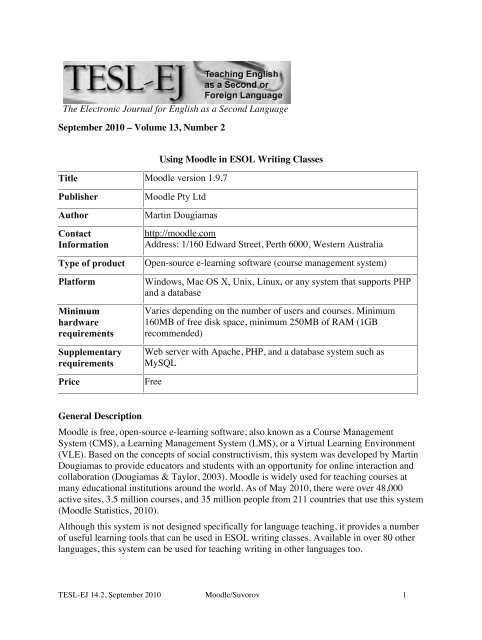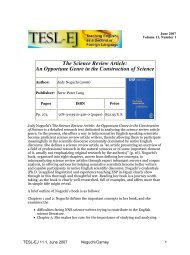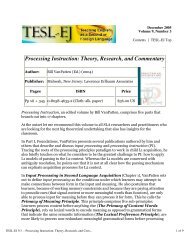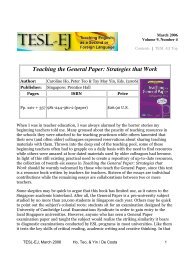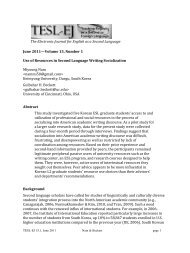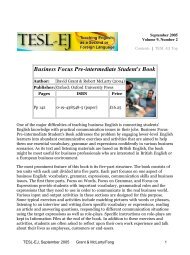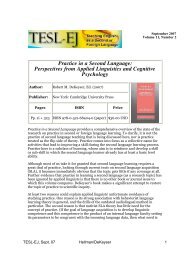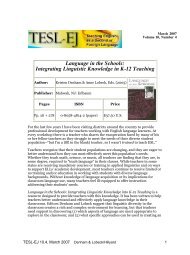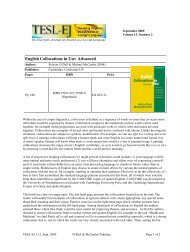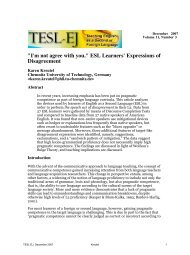Volume 13, Number 2 Using Moodle in ESOL Writing Clas - TESL-EJ
Volume 13, Number 2 Using Moodle in ESOL Writing Clas - TESL-EJ
Volume 13, Number 2 Using Moodle in ESOL Writing Clas - TESL-EJ
Create successful ePaper yourself
Turn your PDF publications into a flip-book with our unique Google optimized e-Paper software.
The Electronic Journal for English as a Second Language<br />
September 2010 – <strong>Volume</strong> <strong>13</strong>, <strong>Number</strong> 2<br />
Title <strong>Moodle</strong> version 1.9.7<br />
<strong>Us<strong>in</strong>g</strong> <strong>Moodle</strong> <strong>in</strong> <strong>ESOL</strong> Writ<strong>in</strong>g <strong>Clas</strong>ses<br />
Publisher<br />
Author<br />
Contact<br />
Information<br />
Type of product<br />
Platform<br />
M<strong>in</strong>imum<br />
hardware<br />
requirements<br />
Supplementary<br />
requirements<br />
Price<br />
<strong>Moodle</strong> Pty Ltd<br />
Mart<strong>in</strong> Dougiamas<br />
http://moodle.com<br />
Address: 1/160 Edward Street, Perth 6000, Western Australia<br />
Open-source e-learn<strong>in</strong>g software (course management system)<br />
W<strong>in</strong>dows, Mac OS X, Unix, L<strong>in</strong>ux, or any system that supports PHP<br />
and a database<br />
Varies depend<strong>in</strong>g on the number of users and courses. M<strong>in</strong>imum<br />
160MB of free disk space, m<strong>in</strong>imum 250MB of RAM (1GB<br />
recommended)<br />
Web server with Apache, PHP, and a database system such as<br />
MySQL<br />
Free<br />
General Description<br />
<strong>Moodle</strong> is free, open-source e-learn<strong>in</strong>g software, also known as a Course Management<br />
System (CMS), a Learn<strong>in</strong>g Management System (LMS), or a Virtual Learn<strong>in</strong>g Environment<br />
(VLE). Based on the concepts of social constructivism, this system was developed by Mart<strong>in</strong><br />
Dougiamas to provide educators and students with an opportunity for onl<strong>in</strong>e <strong>in</strong>teraction and<br />
collaboration (Dougiamas & Taylor, 2003). <strong>Moodle</strong> is widely used for teach<strong>in</strong>g courses at<br />
many educational <strong>in</strong>stitutions around the world. As of May 2010, there were over 48,000<br />
active sites, 3.5 million courses, and 35 million people from 211 countries that use this system<br />
(<strong>Moodle</strong> Statistics, 2010).<br />
Although this system is not designed specifically for language teach<strong>in</strong>g, it provides a number<br />
of useful learn<strong>in</strong>g tools that can be used <strong>in</strong> <strong>ESOL</strong> writ<strong>in</strong>g classes. Available <strong>in</strong> over 80 other<br />
languages, this system can be used for teach<strong>in</strong>g writ<strong>in</strong>g <strong>in</strong> other languages too.<br />
<strong>TESL</strong>-<strong>EJ</strong> 14.2, September 2010 <strong>Moodle</strong>/Suvorov 1
A typical <strong>Moodle</strong> course consists of a set of tools that allow for the <strong>in</strong>tegration of a wide<br />
range of assignments, activities, and multimedia resources (both <strong>in</strong>ternal and external),<br />
electronic delivery of teach<strong>in</strong>g materials (such as documents, presentations, audio and video<br />
files), synchronous and asynchronous teacher-student and student-student communication (for<br />
example, chats and forums), and test<strong>in</strong>g and assessment of students’ work.<br />
Technological Features<br />
Be<strong>in</strong>g a web-based system, <strong>Moodle</strong> can be <strong>in</strong>stalled on any web server with Apache, PHP,<br />
and a database system such as MySQL. For those who do not have a ready-to-use server, the<br />
system developers offer all-<strong>in</strong>-one packages that make it easy to <strong>in</strong>stall <strong>Moodle</strong> on any<br />
personal computer runn<strong>in</strong>g Mac OS X or W<strong>in</strong>dows.<br />
The version of <strong>Moodle</strong> reviewed here was 1.9.7. It was hosted on the Mac OS X Server 10.5.6<br />
and runn<strong>in</strong>g on the ISUComm <strong>Moodle</strong> site (ISUComm <strong>Moodle</strong>, 2010) that manages courses<br />
taught <strong>in</strong> the ISUComm program and Department of English at Iowa State University. The<br />
system was evaluated us<strong>in</strong>g a MacBook Pro with three browsers: Internet Explorer version 7,<br />
Mozilla Firefox version 3.5.9, and Safari version 4.0.5. Overall the system worked smoothly<br />
<strong>in</strong> all browsers except that Safari did not display the HTML editor toolbar <strong>in</strong> <strong>Moodle</strong>.<br />
By default, a <strong>Moodle</strong> course has a three-column layout with the side columns consist<strong>in</strong>g of<br />
blocks with course sett<strong>in</strong>gs and <strong>in</strong>formation, and the center column conta<strong>in</strong><strong>in</strong>g the course<br />
content (see Figure 1). <strong>Moodle</strong> has a good built-<strong>in</strong> help system available for most of the<br />
sett<strong>in</strong>gs. Any element with<strong>in</strong> a <strong>Moodle</strong> course can be edited, thus mak<strong>in</strong>g the system highly<br />
customizable.<br />
Figure 1. Sample <strong>Moodle</strong> course<br />
<strong>TESL</strong>-<strong>EJ</strong> 14.2, September 2010 <strong>Moodle</strong>/Suvorov 2
The <strong>Moodle</strong> <strong>in</strong>terface is very user-friendly. All resources and activities are accessible through<br />
hyperl<strong>in</strong>ks. A remarkable feature of <strong>Moodle</strong> that makes this CMS easy to use and navigate is<br />
that all course elements are presented on a s<strong>in</strong>gle page, thus obviat<strong>in</strong>g any need for sub-menus<br />
or multi-level, folder-based organization.<br />
Be<strong>in</strong>g an open-source system, <strong>Moodle</strong> allows for <strong>in</strong>tegration of third-party modules, filters,<br />
and plug-<strong>in</strong>s that are freely available onl<strong>in</strong>e (<strong>Moodle</strong> Modules and Plug<strong>in</strong>s, 2010). However,<br />
the quality of some of these third-party products is questionable, so add<strong>in</strong>g them to <strong>Moodle</strong><br />
can subvert the system security and performance.<br />
F<strong>in</strong>ally, <strong>Moodle</strong> facilitates monitor<strong>in</strong>g of students’ work through <strong>in</strong>dividual automatic log<br />
reports that conta<strong>in</strong> <strong>in</strong>formation about the type of work completed and the amount of time<br />
spent on each assignment by each student. Moreover, the system allows the <strong>in</strong>structor to<br />
specify timeframes for complet<strong>in</strong>g activities and set restrictions on submitt<strong>in</strong>g assignments or<br />
complet<strong>in</strong>g onl<strong>in</strong>e tasks if the deadl<strong>in</strong>e has passed. Such extensive monitor<strong>in</strong>g enables the<br />
language <strong>in</strong>structor to better understand students’ progress and assess the extent to which they<br />
engage <strong>in</strong> learn<strong>in</strong>g.<br />
Activities<br />
Even though all activities <strong>in</strong> <strong>Moodle</strong> must be set up by an <strong>in</strong>structor, students can be allowed<br />
to add resources and learn<strong>in</strong>g content to many of them. To access activities <strong>in</strong> a <strong>Moodle</strong><br />
course, students first need to create a <strong>Moodle</strong> account and, if the course is passwordprotected,<br />
use an enrollment key, which is a one-time password.<br />
While there is a plethora of different activity types <strong>in</strong> <strong>Moodle</strong> that can be used <strong>in</strong> <strong>ESOL</strong><br />
writ<strong>in</strong>g classes, the follow<strong>in</strong>g section provides a brief description and evaluation of some of<br />
the most common ones.<br />
Assignment<br />
This is one of the most widely used activities <strong>in</strong> <strong>Moodle</strong> with four different types of<br />
assignments. The first two types —“Upload a s<strong>in</strong>gle file” and “Advanced upload<strong>in</strong>g of<br />
files”—allow students to upload their work <strong>in</strong> any digital format (for <strong>in</strong>stance, text files,<br />
spreadsheets, or PowerPo<strong>in</strong>t presentations) to <strong>Moodle</strong>. <strong>ESOL</strong> students, however, can compose<br />
directly <strong>in</strong> <strong>Moodle</strong> us<strong>in</strong>g the “Onl<strong>in</strong>e text” assignment, a remarkable feature of which is an<br />
HTML editor that can be used to add and edit text, tables, images, l<strong>in</strong>ks, and multimedia (see<br />
Figure 2).<br />
<strong>TESL</strong>-<strong>EJ</strong> 14.2, September 2010 <strong>Moodle</strong>/Suvorov 3
Figure 2. Sample onl<strong>in</strong>e text assignment <strong>in</strong> <strong>Moodle</strong> (student view)<br />
Forum<br />
<strong>Moodle</strong> offers different types of forums to provide versatile opportunities for onl<strong>in</strong>e<br />
discussions <strong>in</strong> <strong>ESOL</strong> writ<strong>in</strong>g classes. In the “S<strong>in</strong>gle simple discussion” forum, students’<br />
responses to the <strong>in</strong>structor’s <strong>in</strong>itial post are displayed on a s<strong>in</strong>gle page, as shown <strong>in</strong> Figure 3.<br />
The “Standard forum for general use” allows students not only to reply to the <strong>in</strong>structor’s<br />
questions, but also to <strong>in</strong>itiate their own discussions. The “Q and A forum” can be used to<br />
promote <strong>in</strong>dividual th<strong>in</strong>k<strong>in</strong>g and creativity as it requires students to post before they can view<br />
and respond to other students’ post<strong>in</strong>gs. F<strong>in</strong>ally, the “Each person posts one discussion”<br />
forum allows students to make only one post.<br />
Figure 3. Sample s<strong>in</strong>gle simple discussion forum <strong>in</strong> <strong>Moodle</strong><br />
<strong>TESL</strong>-<strong>EJ</strong> 14.2, September 2010 <strong>Moodle</strong>/Suvorov 4
Chat<br />
A chat room <strong>in</strong> <strong>Moodle</strong> can be used for synchronous communication among <strong>ESOL</strong> students<br />
and their <strong>in</strong>structor. As can be seen <strong>in</strong> Figure 4, <strong>Moodle</strong> chat doesn’t have voice or video<br />
options, thus limit<strong>in</strong>g <strong>in</strong>teractions only to text. Although this is generally a disadvantage, the<br />
lack of voice and video can actually benefit students <strong>in</strong> <strong>ESOL</strong> writ<strong>in</strong>g classes by mak<strong>in</strong>g them<br />
exclusively employ their writ<strong>in</strong>g skills.<br />
Glossary<br />
Figure 4. Sample chat room <strong>in</strong> <strong>Moodle</strong><br />
The Glossary activity enables students to create a set of text entries and is particularly useful<br />
for develop<strong>in</strong>g <strong>ESOL</strong> students’ vocabulary (see Figure 5). The entries can be searched and<br />
browsed <strong>in</strong> various ways, grouped <strong>in</strong>to categories, and l<strong>in</strong>ked to other resources <strong>in</strong> <strong>Moodle</strong>.<br />
Students can also leave comments on each other’s contributions to the glossary.<br />
<strong>TESL</strong>-<strong>EJ</strong> 14.2, September 2010 <strong>Moodle</strong>/Suvorov 5
Figure 5. Sample glossary <strong>in</strong> <strong>Moodle</strong><br />
Database<br />
This powerful tool can be used to build a database of entries <strong>in</strong> virtually any format, <strong>in</strong>clud<strong>in</strong>g<br />
different types of files, text, numbers or URLs. Students can be required to submit a certa<strong>in</strong><br />
number of entries before view<strong>in</strong>g other entries <strong>in</strong> the database. They can also rate and leave<br />
feedback on other entries. Figure 6 provides an example of a database of students’ PowerPo<strong>in</strong>t<br />
presentations.<br />
Figure 6. Sample database <strong>in</strong> <strong>Moodle</strong><br />
<strong>TESL</strong>-<strong>EJ</strong> 14.2, September 2010 <strong>Moodle</strong>/Suvorov 6
Wiki<br />
A wiki activity provides space <strong>in</strong> <strong>Moodle</strong> for collaborative work. It allows students to create<br />
web pages <strong>in</strong>side of <strong>Moodle</strong>, do peer reviews of each other’s work, and collaborate on group<br />
assignments (see Figure 7).<br />
Figure 7. Sample wiki <strong>in</strong> <strong>Moodle</strong><br />
Workshop<br />
<strong>Moodle</strong> Workshop serves as a platform for peer response sessions. Students can upload their<br />
work to the workshop and provide peer feedback and evaluation us<strong>in</strong>g rubrics and criteria<br />
available with<strong>in</strong> this activity. One of the most complex activities <strong>in</strong> <strong>Moodle</strong> from a<br />
pedagogical viewpo<strong>in</strong>t, the Workshop is also technologically complex and, unfortunately,<br />
suffers from technical glitches and bugs. This module is be<strong>in</strong>g completely rewritten for<br />
<strong>Moodle</strong> version 2.0.<br />
Depend<strong>in</strong>g on activity types, the work that students submit <strong>in</strong> <strong>Moodle</strong> can be graded either<br />
automatically by the system or manually by the <strong>in</strong>structor. All grades and feedback are stored<br />
<strong>in</strong> the <strong>Moodle</strong> gradebook, which students can access by click<strong>in</strong>g on the “Grades” l<strong>in</strong>k located<br />
on the ma<strong>in</strong> course page.<br />
Teacher Fit (Approach)<br />
To determ<strong>in</strong>e the usefulness of <strong>Moodle</strong> and its tools for <strong>ESOL</strong> writ<strong>in</strong>g, it is important to<br />
exam<strong>in</strong>e the theoretical underp<strong>in</strong>n<strong>in</strong>gs of this system. Accord<strong>in</strong>g to the founder of <strong>Moodle</strong>,<br />
this CMS was built on the basis of socio-constructivist pedagogy (Dougiamas & Taylor,<br />
2003). Social constructivism allows for “a student-centered environment where learners are<br />
able to work <strong>in</strong>dependently, reflect<strong>in</strong>g on their own work and on the work of other students,<br />
while at the same time be<strong>in</strong>g connected to a group of learners who can share ideas and reflect<br />
on each other’s work” (Mougalian & Salazar, 2006, p. 3). Such student-centered<br />
<strong>TESL</strong>-<strong>EJ</strong> 14.2, September 2010 <strong>Moodle</strong>/Suvorov 7
environments, which accord<strong>in</strong>g to Bransford (2000) <strong>in</strong>clude “a sensitivity to the cultural<br />
practices of students” and respect their “language practices,” are especially beneficial for<br />
<strong>ESOL</strong> learners who usually come from different cultural and language backgrounds (p. <strong>13</strong>5).<br />
The analysis of activities available <strong>in</strong> <strong>Moodle</strong> <strong>in</strong>dicates that many of them <strong>in</strong>deed are based on<br />
social constructivism. The modules such as Glossary and Database enable students to<br />
construct both their own knowledge and community knowledge through contributions of<br />
entries. These learner-centered activities alter power relations <strong>in</strong> the <strong>Moodle</strong> environment by<br />
shift<strong>in</strong>g the emphasis from teacher-structured to student-directed learn<strong>in</strong>g.<br />
Learner centeredness, <strong>in</strong> turn, promotes collaboration and <strong>in</strong>teraction among students, and<br />
between students and their <strong>in</strong>structor. Most of the described <strong>Moodle</strong> activities (e.g., Forum,<br />
Chat, Glossary, Database, Wiki, and Workshop) are collaborative <strong>in</strong> nature and encourage<br />
active participation and <strong>in</strong>teraction. These collaborative activities allow students to coconstruct<br />
writ<strong>in</strong>g, which accord<strong>in</strong>g to Murray (1992), is “not a solitary enterprise” but “a<br />
social act” and is “the result of the <strong>in</strong>teraction among people, contexts and texts” (p. 100).<br />
Additionally, the “Group” feature <strong>in</strong> <strong>Moodle</strong> provides opportunities for collaborative writ<strong>in</strong>g<br />
by divid<strong>in</strong>g students <strong>in</strong>to different groups, both on the level of an <strong>in</strong>dividual activity and on a<br />
course level. Thus, through learner-centeredness, collaboration, and <strong>in</strong>teraction—which,<br />
accord<strong>in</strong>g to Brown (1994), is “the heart of communication” (p. 159)—<strong>Moodle</strong> activities<br />
conform to the pr<strong>in</strong>ciples of communicative language teach<strong>in</strong>g. However, unlike other<br />
environments (for example, blogs) which are publicly open and allow for a wide audience,<br />
<strong>Moodle</strong> is an access-restricted system, <strong>in</strong> which communication and <strong>in</strong>teraction is limited to<br />
course users.<br />
Another major theoretical underp<strong>in</strong>n<strong>in</strong>g of us<strong>in</strong>g this CMS for writ<strong>in</strong>g courses is the process<br />
approach to writ<strong>in</strong>g that emphasizes prewrit<strong>in</strong>g, draft<strong>in</strong>g, revis<strong>in</strong>g, and edit<strong>in</strong>g, and regards<br />
writ<strong>in</strong>g as “a th<strong>in</strong>k<strong>in</strong>g process” (Brown, 1994, p. 321). Many activities <strong>in</strong> <strong>Moodle</strong> focus on the<br />
process of writ<strong>in</strong>g and help students better understand their own compos<strong>in</strong>g process. For<br />
example, Forums encourage students to engage <strong>in</strong> pre-writ<strong>in</strong>g and draft<strong>in</strong>g, Wikis and<br />
Workshops place importance on revision and feedback, and the Assignment activity allows<br />
students to submit their f<strong>in</strong>al written products.<br />
However, with a reduced emphasis on rhetorical structure, vocabulary, and grammar, the<br />
process-centered methodology presupposes that language learners will acquire English<br />
proficiency naturally and, therefore, grammar and vocabulary issues should be addressed only<br />
as needed <strong>in</strong> the context of writ<strong>in</strong>g. Accord<strong>in</strong>g to H<strong>in</strong>kel (2004), exclusive reliance on the<br />
process-centered paradigm <strong>in</strong> <strong>ESOL</strong> classes overlooks students’ lack of advanced L2 skills<br />
that are necessary “to take advantage of the benefits of writ<strong>in</strong>g process <strong>in</strong>struction” (p. 9).<br />
Consequently, H<strong>in</strong>kel (2004) advocates “extensive, thorough, and focused <strong>in</strong>struction <strong>in</strong> L2<br />
academic vocabulary, grammar, and discourse” which is <strong>in</strong>dispensable for improvement of<br />
the overall quality of <strong>ESOL</strong> students’ writ<strong>in</strong>g (p. 7). Thus, the process-centered nature of<br />
many of the <strong>Moodle</strong> activities described <strong>in</strong> this review and their lack of l<strong>in</strong>guistic focus<br />
(except for the Glossary activity) could be a noticeable limitation of this CMS for teach<strong>in</strong>g L2<br />
writ<strong>in</strong>g unless the <strong>in</strong>structor takes <strong>in</strong>itiative to address vocabulary, grammar, and discourse<br />
issues.<br />
<strong>TESL</strong>-<strong>EJ</strong> 14.2, September 2010 <strong>Moodle</strong>/Suvorov 8
Learner Fit (Design)<br />
Due to its great flexibility and customizability, <strong>Moodle</strong> can be used for teach<strong>in</strong>g writ<strong>in</strong>g to all<br />
levels of language learners <strong>in</strong> a face-to-face, hybrid, or onl<strong>in</strong>e format. Although this CMS<br />
encourages process writ<strong>in</strong>g, it can be adapted for product-oriented writ<strong>in</strong>g too. Students can<br />
have significant control of their learn<strong>in</strong>g as the system provides them with opportunities to<br />
create their own knowledge and learn<strong>in</strong>g content. Although <strong>Moodle</strong> is very <strong>in</strong>tuitive and userfriendly,<br />
its use requires at least basic computer skills on the part of the students. Thus, learner<br />
tra<strong>in</strong><strong>in</strong>g <strong>in</strong> terms of content management and the use of the system features is highly<br />
recommended, especially for students who lack computer literacy.<br />
<strong>Moodle</strong> can appeal to students with different learn<strong>in</strong>g styles as it allows for various types of<br />
activities and multimodal <strong>in</strong>put such as video, audio, and text. Additionally, the activities can<br />
be designed for both <strong>in</strong>dividual and group work. Furthermore, modules such as Quiz and<br />
Lesson provide different assessment options and the <strong>Moodle</strong> gradebook (see Figure 8) allows<br />
students to receive feedback on their work and keep track of their progress <strong>in</strong> class.<br />
Figure 8. Sample <strong>Moodle</strong> gradebook (version 1.9.7)<br />
F<strong>in</strong>ally, this CMS can be adapted to the particular writ<strong>in</strong>g needs of L2 students. For example,<br />
l<strong>in</strong>k<strong>in</strong>g <strong>ESOL</strong> writ<strong>in</strong>g courses with discipl<strong>in</strong>e-specific courses hosted <strong>in</strong> the <strong>Moodle</strong><br />
environment allows for <strong>in</strong>tegrated content-based <strong>in</strong>struction. Also, the <strong>in</strong>tegration of the<br />
Corpus module with a concordancer and creation of learner corpora <strong>in</strong> <strong>Moodle</strong> can allow for<br />
corpus-based teach<strong>in</strong>g and learn<strong>in</strong>g.<br />
Summary<br />
<strong>Moodle</strong> is a versatile course management system that has great potential for language<br />
teach<strong>in</strong>g <strong>in</strong> various formats. It allows for <strong>in</strong>teractive learn<strong>in</strong>g, collaborative work, and studentled<br />
construction of learn<strong>in</strong>g content. The system can be customized and adapted to meet the<br />
specific needs of writ<strong>in</strong>g classes and <strong>in</strong>dividual learners. However, as mentioned by Brandl<br />
(2005), <strong>Moodle</strong> “is not a panacea for language learn<strong>in</strong>g” (p. 22) and it is not designed<br />
<strong>TESL</strong>-<strong>EJ</strong> 14.2, September 2010 <strong>Moodle</strong>/Suvorov 9
specifically for teach<strong>in</strong>g foreign languages. Hence, language <strong>in</strong>structors must exercise caution<br />
when us<strong>in</strong>g this system and base the design of learn<strong>in</strong>g tasks and activities on theoretical<br />
pr<strong>in</strong>ciples of second language acquisition and classroom pedagogy.<br />
References<br />
Brandl, K. (2005). Are you ready to “<strong>Moodle</strong>”? Language Learn<strong>in</strong>g & Technology, 9(2), 16-<br />
23.<br />
Bransford, J. (2000). How people learn: Bra<strong>in</strong>, m<strong>in</strong>d, experience, and school. Wash<strong>in</strong>gton,<br />
D.C.: National Academy Press.<br />
Brown, H. D. (1994). Teach<strong>in</strong>g by pr<strong>in</strong>ciples: An <strong>in</strong>teractive approach to language pedagogy.<br />
Englewood Cliffs, NJ: Prentice Hall Regents.<br />
Dougiamas, M., & Taylor, P. (2003). <strong>Moodle</strong>: <strong>Us<strong>in</strong>g</strong> learn<strong>in</strong>g communities to create an open<br />
source course management system. Proceed<strong>in</strong>gs of the EDMEDIA 2003 Conference,<br />
Honolulu, Hawaii. Retrieved October 6, 2009, from<br />
http://dougiamas.com/writ<strong>in</strong>g/edmedia2003/<br />
H<strong>in</strong>kel, E. (2004). Teach<strong>in</strong>g academic ESL writ<strong>in</strong>g: Practical techniques <strong>in</strong> vocabulary and<br />
grammar. Mahwah, NJ: Lawrence Erlbaum Associates.<br />
ISUComm <strong>Moodle</strong>. (2010). Retrieved June 17, 2010, from http://courses.isucomm.iastate.edu<br />
<strong>Moodle</strong> Modules and Plug<strong>in</strong>s. (2010). Retrieved June 17, 2010, from<br />
http://moodle.org/mod/data/view.php?id=6009<br />
<strong>Moodle</strong> Statistics. (2010). Retrieved June 8, 2010, from http://moodle.org/stats/<br />
Mougalian, C., & Salazar, A. (2006). <strong>Moodle</strong>, the electronic syllabus, lends itself to<br />
PrOCALL. Retrieved April 6, 2009, from<br />
http://faculty.miis.edu/~bcole/CALLme/page2/page9/page9.html<br />
Murray, D. (1992). Collaborative learn<strong>in</strong>g as literacy event: Implications for ESL <strong>in</strong>struction.<br />
In D. Nunan (Ed.), Collaborative language learn<strong>in</strong>g and teach<strong>in</strong>g (pp. 100-117). Cambridge:<br />
Cambridge University Press.<br />
<strong>TESL</strong>-<strong>EJ</strong> 14.2, September 2010 <strong>Moodle</strong>/Suvorov 10
About the Reviewer<br />
Ruslan Suvorov is a doctoral student <strong>in</strong> Applied L<strong>in</strong>guistics and Technology with a m<strong>in</strong>or <strong>in</strong><br />
Curriculum and Instructional Technology at Iowa State University. He teaches English<br />
courses and works as an <strong>in</strong>structional technology coord<strong>in</strong>ator for the ISUComm <strong>Moodle</strong>. His<br />
research <strong>in</strong>terests <strong>in</strong>clude language test<strong>in</strong>g, computer-assisted language learn<strong>in</strong>g, and the use<br />
of <strong>in</strong>structional technology for hybrid and onl<strong>in</strong>e learn<strong>in</strong>g.<br />
<br />
© Copyright rests with authors. Please cite <strong>TESL</strong>-<strong>EJ</strong><br />
appropriately.<br />
Copyright © 1994 - 2010 <strong>TESL</strong>-<strong>EJ</strong>, ISSN 1072-4303<br />
Copyright rests with the authors.<br />
<strong>TESL</strong>-<strong>EJ</strong> 14.2, September 2010 <strong>Moodle</strong>/Suvorov 11


